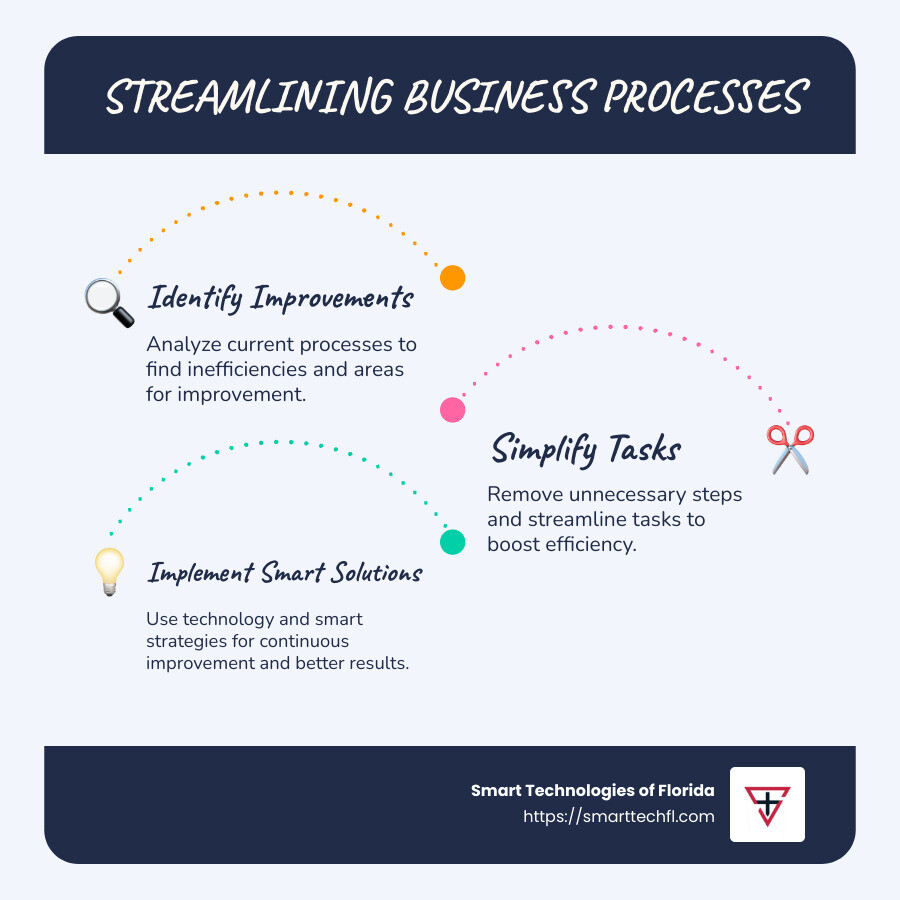Streamlining 101: Understanding Business Process Optimization
What is streamlining business processes?
Streamlining business processes is all about enhancing efficiency, boosting productivity, and increasing profitability by simplifying tasks and cutting out unnecessary steps.
In today’s business world, many organizations feel stuck with outdated procedures that waste time and drain resources. Streamlining turns these challenges into opportunities for growth and success, providing a clear path to better operations and more satisfied customers.
Why should you care? Because a smooth, well-organized workflow not only saves time and money but also empowers your team and delights your customers. By optimizing how tasks are done, companies can respond quicker to market needs, reduce errors, and focus on what truly matters: delivering value.
Smart solutions and a focus on continuous improvement help businesses like yours stay competitive, ensuring that your retail operations not only survive but thrive in the digital age.

What is Streamlining Business Processes?
Streamlining business processes is the art of simplification. Picture this: a tangled web of tasks, each one dependent on the next, creating a bottleneck of inefficiency. Streamlining cuts through this complexity, stripping away the unnecessary and leaving only what is essential.
Eliminating steps is at the heart of streamlining. Imagine a purchase order process that requires approval from five different departments. By reducing approvals to just the essential ones, not only does the process speed up, but it also reduces the chance for errors. This kind of refinement leads directly to greater operational efficiency.
Operational efficiency is the name of the game. When processes are streamlined, businesses can achieve more with less. They reduce costs, save time, and improve output quality. Employees can focus on tasks that add real value, rather than getting bogged down in redundant procedures.

Consider this: A company that used to take two weeks to process orders can now do it in just two days. This isn’t just a win for the business; it’s a win for the customer, who receives their order faster and with fewer errors.
By embracing streamlining, businesses can transform their operations, making them more agile and responsive to change. This isn’t just about cutting corners; it’s about smart, strategic improvements that drive success.
The next step? Learning the best practices that can help you streamline effectively and sustainably.
Benefits of Streamlining Business Processes
Streamlining business processes offers a host of benefits that can transform the way an organization operates. Let’s explore some of the key advantages:
Increased Efficiency
Efficiency is the cornerstone of streamlining. By simplifying processes and eliminating unnecessary steps, tasks that once took hours can now be completed in minutes. This change isn’t just theoretical. Take, for example, a company that reduced its order processing time from two weeks to just two days. Such improvements free up valuable time for employees to focus on more meaningful work, enhancing productivity across the board.
Cost Reduction
Streamlining often goes hand-in-hand with cost savings. By cutting out redundant steps and automating repetitive tasks, companies can significantly reduce operational expenses. Automation plays a crucial role here, as it minimizes manual labor and the potential for human error. In fact, many businesses report large-scale cost savings after implementing streamlined processes, allowing them to allocate resources more effectively.
Improved Employee Satisfaction
Streamlining processes can lead to a happier workforce. When employees aren’t bogged down by inefficient procedures, they experience less frustration and more job satisfaction. Streamlined processes promote transparency and collaboration, creating a work environment where employees feel empowered and valued. By eliminating barriers to productivity, employees can focus on tasks that truly matter, fostering professional growth and career development.
Improved Customer Satisfaction
Customers benefit greatly from streamlined processes. Faster service delivery, improved product quality, and consistent performance are just a few of the perks that come with efficient operations. As businesses pass cost savings down to customers, they can offer competitive pricing and better service. This, in turn, boosts customer loyalty and satisfaction. When customer experience is king, streamlining can be a game-changer for maintaining a competitive edge.
By focusing on these key benefits, businesses can not only improve their internal operations but also improve their external reputation. Streamlining is more than just a buzzword—it’s a strategic approach to achieving long-term success.
Ready to take your streamlining efforts to the next level? Let’s explore the top tips for effectively streamlining your business processes.
Top 5 Tips to Streamline Processes
Streamlining business processes is essential for achieving efficiency and productivity. Let’s explore five practical tips that can help you streamline processes effectively:
1. Study Processes Thoroughly
Before diving into automation, take a step back and study your existing processes. Map them out visually to identify bottlenecks and redundancies. A well-studied process is easier to streamline and automate. For instance, if your finance team struggles with month-end reports, there might be outdated steps that can be optimized. By understanding the current state, you can make informed decisions on what needs improvement.
2. Prioritize Applications First
Focus on applications that offer immediate benefits. Start with processes that are high in frequency but low in complexity. Automating these processes can yield quick wins and encourage further streamlining efforts. For example, automating invoice processing can reduce errors and speed up approvals. By tackling straightforward tasks first, you build momentum for more complex projects.
3. Check Return on Investment (ROI)
Streamlining should lead to measurable benefits. Evaluate the ROI of your process improvements. This involves looking at time savings, cost reductions, and increased productivity. A successful streamlining initiative should pay for itself over time. Ensure you have metrics in place to track progress and justify the investment to stakeholders.
4. Think Long Term
While immediate gains are important, consider the long-term impact of your streamlining efforts. Processes and technologies evolve, so your solutions should be flexible and scalable. Implement systems that can adapt to future changes and growth. This forward-thinking approach ensures that your streamlined processes remain efficient and relevant over time.
5. Use Readymade Solutions
Leverage ready-to-use solutions that are designed to streamline processes. Tools like ClickUp offer templates and integrations that simplify workflow management. These solutions save time and resources, allowing you to focus on core business activities. By using established platforms, you can avoid reinventing the wheel and benefit from proven methodologies.
By following these tips, you can effectively streamline processes in your organization, leading to improved efficiency and productivity. Let’s explore the 10 Best Practices to Streamline Business Processes.
10 Best Practices to Streamline Business Processes
Streamlining business processes is about making operations more efficient and effective. Here are ten best practices to guide you:
1. Map Processes
Begin by mapping out your current processes. Visual diagrams help you see each step clearly. This allows you to spot inefficiencies and areas needing improvement. For example, when a company mapped its purchase order process, it found redundant approvals that slowed down operations.
2. Tie to Outcomes
Align every process with your business goals. Ask yourself: Does this process support our objectives? If it doesn’t, it’s time to rethink it. Processes should drive results, not just be tasks to complete.
3. Identify Improvements
Use data analytics to find bottlenecks and inefficiencies. Tools like product analytics can help you see where resources are wasted. Prioritize improvements based on their impact on business outcomes.
4. Simplify and Standardize
Simplify processes by cutting unnecessary steps. Standardize tasks across departments to ensure consistency. For instance, using a single form for all departments can reduce confusion and speed up processing times.
5. Leverage Lean Principles
Adopt lean methodologies to eliminate waste and improve value. Lean focuses on continuous improvement and efficiency. By applying principles like just-in-time production, you can streamline workflows and reduce delays.
6. Improve Communication
Centralize your communication and work tools. This reduces the need to switch between apps, which can cause fatigue and miscommunication. A centralized platform keeps everyone on the same page.
7. Support with Digital Adoption Platforms (DAP)
Digital Adoption Platforms help employees learn new systems quickly. They provide guidance and support, ensuring smooth transitions when new tools are introduced. This minimizes disruptions and maximizes efficiency.
8. Test Workflow
Before fully implementing changes, test your workflows. This allows you to identify potential issues and make adjustments. Testing ensures that the new processes work as intended and are ready for full-scale deployment.
9. Refine and Optimize
Streamlining is an ongoing process. Regularly review and refine your workflows. Continuous optimization leads to sustained improvements and keeps processes aligned with changing business needs.
10. Focus on Customer Impact
Always consider how changes affect your customers. Streamlined processes should improve customer satisfaction by improving service delivery and reducing wait times. Happy customers are a sign of successful process optimization.
By following these best practices, you can transform inefficiencies into competitive advantages. Ready to address common questions? Let’s move on to the Frequently Asked Questions about Streamlining Business Processes.
Frequently Asked Questions about Streamlining Business Processes
What is a streamline business process?
A streamline business process involves simplifying tasks to improve efficiency. Imagine a river flowing smoothly without obstacles. Streamlining is like removing the rocks and branches that slow down the flow. By cutting unnecessary steps, you allow processes to move quickly and efficiently. For example, using a single digital form instead of multiple paper forms can save time and reduce errors.
How do you explain streamlining?
Streamlining is about shaping processes for efficiency. It’s like designing a car to cut through the air with minimal resistance. In business, this means organizing tasks so they flow smoothly and quickly. When you streamline, you eliminate bottlenecks and redundancies, allowing your team to focus on what matters most. This approach not only improves speed but also improves overall productivity.
What is the difference between streamline and optimize?
Streamline and optimize are related but distinct concepts. Streamlining is a gradual approach that focuses on simplifying and speeding up processes. It’s about making tasks easier and faster by removing unnecessary steps.
On the other hand, optimization involves a more detailed review. It’s about fine-tuning processes to achieve the best possible outcome. Optimization looks at every aspect of a process to improve performance, often using data and analytics to make informed decisions.
In short, streamlining is about quick improvements for efficiency, while optimization is a deeper dive into maximizing effectiveness. Both are crucial for achieving operational excellence.
Conclusion
At Smart Technologies of Florida, we believe that strategic change and innovation are the keys to open uping your business’s full potential. With over 23 years of experience, we’ve seen how streamlined processes can transform organizations, making them more agile, efficient, and ready to tackle the challenges of tomorrow.
Streamlining isn’t just about cutting costs or speeding up processes. It’s about reimagining how your business operates. By focusing on eliminating inefficiencies and simplifying workflows, we help businesses achieve more with less. This approach not only boosts productivity but also improves employee and customer satisfaction.
Our people-centric approach ensures that any change aligns with your unique goals. We work closely with you to understand your needs and tailor solutions that fit your organization perfectly. By leveraging cutting-edge digital solutions, we empower your business to innovate and stay ahead of the competition.
Ready to streamline your business processes and drive innovation? Learn more about how our business process automation solutions can help you achieve strategic change and operational excellence.
Together, let’s shape the future of your business—efficiently and innovatively.












